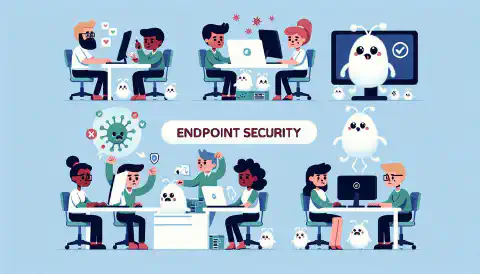Demystifying Cybersecurity Jargon: Your Guide to Digital Defense

Table of Contents
Understanding Cybersecurity Jargon
In the ever-evolving world of cybersecurity, professionals often rely on a complex web of terminology to describe various threats, technologies, and practices. For those not well-versed in this field, deciphering cybersecurity jargon can be a daunting task. This article aims to demystify some of the most common cybersecurity terms, providing clarity to both newcomers and seasoned experts.
Introduction: Navigating the Cybersecurity Labyrinth
Cybersecurity is a critical component of our digital age, as businesses and individuals increasingly rely on technology for various aspects of their lives. With the growing complexity of cyber threats, a specialized language has emerged to discuss and address these issues effectively.
In this article, we will dive into the world of cybersecurity jargon, breaking down key terms and concepts. Whether you’re a cybersecurity novice or an experienced professional, understanding this terminology is crucial for safeguarding your digital assets.
Threat Vectors and Attack Types
Malware
Malware, short for malicious software , encompasses a wide range of malicious programs designed to infiltrate and compromise computer systems. Common types include viruses, Trojans, and ransomware. To protect against malware, it’s essential to use reliable antivirus software .
Phishing
Phishing attacks involve tricking individuals into divulging sensitive information or downloading malicious files. Cybercriminals often impersonate trustworthy entities, such as banks or government agencies, to deceive their victims. Understanding the signs of phishing emails is key to staying safe.
DDoS Attacks
Distributed Denial of Service (DDoS) attacks overwhelm a target’s online services, rendering them inaccessible. Organizations need robust DDoS mitigation solutions to counter these threats effectively.
Cybersecurity Technologies
Firewall
A firewall acts as a barrier between a private network and external threats. It filters incoming and outgoing network traffic based on a predefined set of security rules. Modern firewalls provide advanced features like intrusion detection and prevention.
VPN (Virtual Private Network)
A VPN creates a secure, encrypted connection between a user and a remote server. This technology is vital for protecting data while browsing the internet, especially on public Wi-Fi networks.
Two-Factor Authentication (2FA)
Two-Factor Authentication adds an extra layer of security by requiring users to provide two separate authentication factors, such as a password and a unique code sent to their mobile device.
Government Regulations and Compliance: Ensuring Cybersecurity Adherence
In the realm of cybersecurity, government regulations play a significant role in shaping best practices and standards. Staying informed about these regulations is crucial not only to ensure legal compliance but also to enhance security.
GDPR (General Data Protection Regulation)
The General Data Protection Regulation (GDPR) , enforced by the European Union (EU), focuses on data protection and privacy. It imposes strict requirements on organizations handling personal data, with severe penalties for non-compliance. For a detailed understanding of GDPR and its impact, you can refer to the official GDPR website .
HIPAA (Health Insurance Portability and Accountability Act)
HIPAA is a U.S. law that regulates the handling of healthcare information. Healthcare providers and organizations must adhere to strict security measures to protect patient data. You can find comprehensive information about HIPAA and its requirements on the U.S. Department of Health & Human Services HIPAA webpage .
CCPA (California Consumer Privacy Act)
The California Consumer Privacy Act (CCPA) is a state-level regulation in California, USA, that grants consumers rights regarding their personal information. It requires businesses to disclose data collection practices and allows consumers to opt-out of data sales. Explore more about CCPA on the official CCPA website .
NIST Cybersecurity Framework
The National Institute of Standards and Technology (NIST) Cybersecurity Framework provides guidance on managing and reducing cybersecurity risk. While not a regulation, it’s widely adopted as a best practice in the United States. Learn more about the NIST Cybersecurity Framework on the NIST website .
PIPEDA (Personal Information Protection and Electronic Documents Act)
In Canada, the Personal Information Protection and Electronic Documents Act (PIPEDA) governs the collection, use, and disclosure of personal information by private-sector organizations. It emphasizes the importance of consent and safeguards for data handling. Get details on PIPEDA from the Government of Canada website .
Conclusion: Unlocking Cybersecurity Success
In conclusion, navigating the world of cybersecurity jargon is essential for anyone looking to safeguard their digital presence. By understanding the terminology and concepts discussed in this article, you can better protect yourself, your organization, and your data from the ever-present cyber threats.
Stay informed, invest in robust cybersecurity technologies, and ensure compliance with relevant government regulations. By doing so, you can significantly reduce your risk of falling victim to cyberattacks and contribute to a safer digital environment for all.
References
- Malwarebytes - Antivirus Software
- ExpressVPN - What Is a VPN?
- EU General Data Protection Regulation
- U.S. Department of Health & Human Services - HIPAA
Understanding #CybersecurityJargon is crucial in our digital age. Learn key terms and concepts to protect yourself online.






